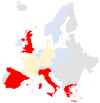Candida auris as an Emergent Public Health Problem: A Current Update on European Outbreaks and Cases
- PMID: 36767000
- PMCID: PMC9914380
- DOI: 10.3390/healthcare11030425
Candida auris as an Emergent Public Health Problem: A Current Update on European Outbreaks and Cases
Abstract
Candida auris is considered to be an emerging fungal pathogen and is related to high mortality rates, persistent candidemia, inconsistencies in susceptibility testing results and misidentification by available commercial identification systems. Multidrug-resistant (MDR) and pandrug-resistant (PDR) strains are increasingly detected. In Europe, hospital outbreaks caused by C. auris have been reported in the United Kingdom (UK), Italy and Spain; however, several cases have been sporadically detected in all European countries. C. auris is difficult to control despite enhanced control measures due to its ability to survive for a long time in environments and colonize patients for prolonged periods. An adequate laboratory diagnostic capacity and national surveillance are fundamental to rapidly detect new C. auris cases and to apply the correct measures to circumscribe them and prevent their spread. Our narrative review aims to highlight the primary C. auris outbreaks and case reports that have occurred in Europe.
Keywords: Candida auris; emerging fungal disease; infectious disease prevention; public health promotion.
Conflict of interest statement
The authors declare no conflict of interest.
Figures



References
-
- Kwon Y.J., Shin J.H., Byun S.A., Choi M.J., Won E.J., Lee D., Lee S.Y., Chun S., Lee J.H., Choi H.J., et al. Candida auris Clinical Isolates from South Korea: Identification, Antifungal Susceptibility, and Genotyping. J. Clin. Microbiol. 2019;57:e01624-18. doi: 10.1128/JCM.01624-18. - DOI - PMC - PubMed
Publication types
LinkOut - more resources
Full Text Sources

